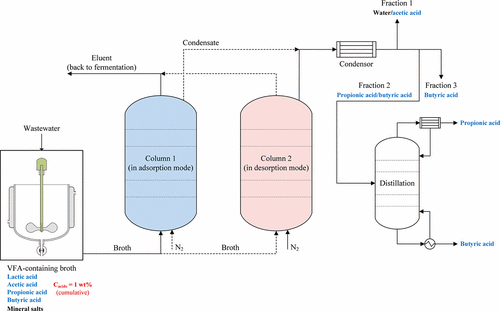当前位置:
X-MOL 学术
›
ACS Sustain. Chem. Eng.
›
论文详情
Our official English website, www.x-mol.net, welcomes your feedback! (Note: you will need to create a separate account there.)
Recovery of Volatile Fatty Acids from Fermented Wastewater by Adsorption
ACS Sustainable Chemistry & Engineering ( IF 8.4 ) Pub Date : 2017-09-19 00:00:00 , DOI: 10.1021/acssuschemeng.7b02095 Ehsan Reyhanitash 1 , Sascha R. A. Kersten 1 , Boelo Schuur 1
ACS Sustainable Chemistry & Engineering ( IF 8.4 ) Pub Date : 2017-09-19 00:00:00 , DOI: 10.1021/acssuschemeng.7b02095 Ehsan Reyhanitash 1 , Sascha R. A. Kersten 1 , Boelo Schuur 1
Affiliation

|
Separation of volatile fatty acids (VFAs) from fermented wastewater is challenging, due to low VFA concentrations in mineral-rich streams. As a result, separation capacity and selectivity with traditional solvents and adsorbents are both compromised. In this study, using a complex artificial model solution mimicking real fermented wastewaters, it is shown that a simple and robust adsorption-based separation technique can retain a remarkable capacity and selectivity for VFAs. Four types of polystyrene-divinylbenzene-based resins (primary, secondary, and tertiary amine-functionalized, and nonfunctionalized) were examined as the adsorbents. The presence of chloride, sulfate, and phosphate salts resulted in coadsorption of their acidic forms HCl, H2SO4, and H3PO4 on amine-functionalized adsorbents, and severely reduced the VFA capacity. With the nonfunctionalized adsorbent, almost no mineral acid coadsorption was observed. This together with a high total VFA capacity of up to 76 g/kg in equilibrium with the model solution containing a total VFA concentration of 1 wt % resulted in a very high selectivity for the VFAs. Nitrogen-stripping with various temperature profiles was applied to regenerate the adsorbent, and study the potential for fractionation of the VFAs during regeneration. Butyric acid (HBu) was obtained in mole fractions of up to 0.8 using a stepwise increase in the stripping temperature from 25 °C via 120 to 200 °C. During four successive adsorption–regeneration cycles, no reduction in the adsorption capacity was observed.
中文翻译:

吸附法回收发酵废水中的挥发性脂肪酸。
由于富含矿物质的流中VFA浓度低,因此从发酵废水中分离挥发性脂肪酸(VFA)具有挑战性。结果,传统溶剂和吸附剂的分离能力和选择性都受到损害。在这项研究中,使用模拟实际发酵废水的复杂人工模型解决方案,结果表明,一种简单而强大的基于吸附的分离技术可以保留对VFA的显着容量和选择性。研究了四种类型的聚苯乙烯-二乙烯基苯基树脂(伯,仲和叔胺官能化和非官能化)作为吸附剂。氯化物,硫酸盐和磷酸盐的存在导致其酸性形式HCl,H 2 SO 4和H 3 PO的共吸附4对胺官能化的吸附剂,严重降低了VFA的容量。使用未官能化的吸附剂,几乎没有观察到无机酸的共吸附。这与平衡状态下的总VFA容量高达76 g / kg以及包含总VFA浓度为1 wt%的模型溶液导致了对VFA的非常高的选择性。应用具有各种温度曲线的氮气汽提法再生吸附剂,并研究再生过程中VFA的分馏潜力。通过将汽提温度从25°C逐步提高到120°C至200°C,可以以高达0.8的摩尔分数获得丁酸(HBu)。在四个连续的吸附-再生循环中,未观察到吸附能力的降低。
更新日期:2017-09-19
中文翻译:

吸附法回收发酵废水中的挥发性脂肪酸。
由于富含矿物质的流中VFA浓度低,因此从发酵废水中分离挥发性脂肪酸(VFA)具有挑战性。结果,传统溶剂和吸附剂的分离能力和选择性都受到损害。在这项研究中,使用模拟实际发酵废水的复杂人工模型解决方案,结果表明,一种简单而强大的基于吸附的分离技术可以保留对VFA的显着容量和选择性。研究了四种类型的聚苯乙烯-二乙烯基苯基树脂(伯,仲和叔胺官能化和非官能化)作为吸附剂。氯化物,硫酸盐和磷酸盐的存在导致其酸性形式HCl,H 2 SO 4和H 3 PO的共吸附4对胺官能化的吸附剂,严重降低了VFA的容量。使用未官能化的吸附剂,几乎没有观察到无机酸的共吸附。这与平衡状态下的总VFA容量高达76 g / kg以及包含总VFA浓度为1 wt%的模型溶液导致了对VFA的非常高的选择性。应用具有各种温度曲线的氮气汽提法再生吸附剂,并研究再生过程中VFA的分馏潜力。通过将汽提温度从25°C逐步提高到120°C至200°C,可以以高达0.8的摩尔分数获得丁酸(HBu)。在四个连续的吸附-再生循环中,未观察到吸附能力的降低。

























 京公网安备 11010802027423号
京公网安备 11010802027423号